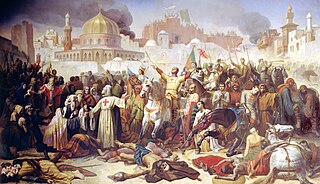
Year 1099 (MXCIX) was a common year starting on Saturday of the Julian calendar.
The 1100s was a decade of the Julian Calendar which began on January 1, 1100, and ended on December 31, 1109.

Year 1102 (MCII) was a common year starting on Wednesday of the Julian calendar.

Year 1105 (MCV) was a common year starting on Sunday of the Julian calendar.

Baldwin I, also known as Baldwin of Boulogne, was the first count of Edessa from 1098 to 1100, and king of Jerusalem from 1100 to his death. He was the youngest son of Eustace II, Count of Boulogne, and Ida of Lorraine and married a Norman noblewoman, Godehilde of Tosny. He received the County of Verdun in 1096, but he soon joined the crusader army of his brother Godfrey of Bouillon and became one of the most successful commanders of the First Crusade.

The Latin Patriarchate of Jerusalem is the Latin Catholic ecclesiastical patriarchate in Jerusalem, officially seated in the Church of the Holy Sepulchre. It was originally established in 1099, with the Kingdom of Jerusalem encompassing the territories in the Holy Land newly conquered by the First Crusade. From 1374 to 1847 it was a titular see, with the patriarchs of Jerusalem being based at the Basilica di San Lorenzo fuori le Mura in Rome. A resident Latin patriarch was re-established in 1847 by Pius IX.

Dagobert was the first Archbishop of Pisa and the second Latin Patriarch of Jerusalem after the city was captured in the First Crusade.
Arnulf of Chocques was a leading member of the clergy during the First Crusade, being made Latin Patriarch of Jerusalem in 1099 and again from 1112 to 1118. Sometimes referred to as Arnulf of Rœulx, presumably after the village of Rœulx some 70km from his home village of Chocques, he was given the nickname Malecorne, meaning badly tonsured.

The count of Tripoli was the ruler of the County of Tripoli, a crusader state from 1102 through 1289. Of the four major crusader states in the Levant, Tripoli was created last.
The archiepiscopal see of Caesarea in Palaestina, also known as Caesarea Maritima, is now a metropolitan see of the Eastern Orthodox Patriarchate of Jerusalem and also a titular see of the Catholic Church. It was one of the earliest Christian bishoprics, and was a metropolitan see at the time of the First Council of Nicaea, but was later subjected to the Patriarchate of Jerusalem. The city remained largely Christian until the Crusades, its bishop maintaining close ties to the Byzantine Empire. After the establishment of the Kingdom of Jerusalem by the crusaders, the see was transformed into a Latin archdiocese, subordinate to the Latin patriarch of Jerusalem.
The Crusades were a series of religious wars initiated, supported, and sometimes directed by the Latin Church in the medieval period. The best known of these Crusades are those to the Holy Land in the period between 1095 and 1291 that were intended to recover Jerusalem and its surrounding area from Islamic rule. Beginning with the First Crusade, which resulted in the recovery of Jerusalem in 1099, dozens of Crusades were fought, providing a focal point of European history for centuries.
Ghibbelin of Sabran was Archbishop of Arles (1080–1112), papal legate (1107–1108), and Latin Patriarch of Jerusalem (1108–1112).

Guglielmo Embriaco, was a Genoese merchant and military leader who came to the assistance of the Crusader States in the aftermath of the First Crusade. Embriaco is considered one of the founders of what would become the Republic of Genoa.

The Archdiocese of Pisa is a metropolitan see of the Catholic Church in Pisa, Italy. It was founded in the 4th century and elevated to the dignity of an archdiocese on 21 April 1092 by Pope Urban II. The seat of the bishop is the cathedral of the Assumption in the Piazza del Duomo.

The siege of Sidon was an event in the aftermath of the First Crusade. The coastal city of Sidon was captured by the forces of Baldwin I of Jerusalem and Sigurd I of Norway, with assistance from the Ordelafo Faliero, Doge of Venice.
Events during the year 1105 in Italy.
The following is an overview of the armies of First Crusade, including the armies of the European noblemen of the "Princes' Crusade", the Byzantine army, a number of Independent crusaders as well as the People’s Crusade and the subsequent Crusade of 1101 and other European campaigns prior to the Second Crusade beginning in 1147.
Maurice was the cardinal-bishop of Porto e Santa Rufina from between 1095 and 1099 until 1102. Following the success of the First Crusade, he was the apostolic legate in the Holy Land from 1100 until his death in 1102. From late 1101 he was also the acting patriarch of Jerusalem.
Robert of Paris was the cardinal-presbyter of Sant'Eusebio from 1100 until his deposition in 1112. He was restored in 1119, but died shortly after. He served as an apostolic legate to the Holy Land in 1102 in the aftermath of the First Crusade, during a critical period in the formation of the Kingdom of Jerusalem.

The siege of Acre took place in May 1104. It was of great importance for the consolidation of the Kingdom of Jerusalem, which had been founded only a few years earlier. With the help of a Genoese fleet, King Baldwin I forced the surrender of the important port city after a siege that lasted only twenty days. Although all defenders and residents wishing to leave the city had been assured by the king that they would be free to leave, taking their chattels with them, many of them had been massacred by the Genoese as they left the city. Moreover, the attackers had also sacked the city itself.











